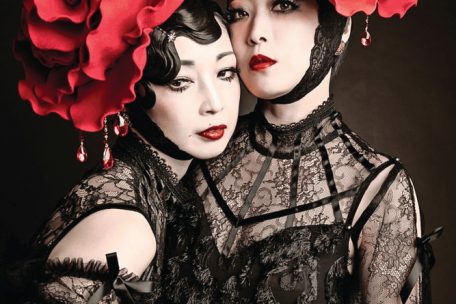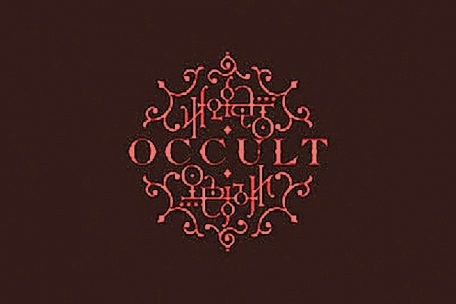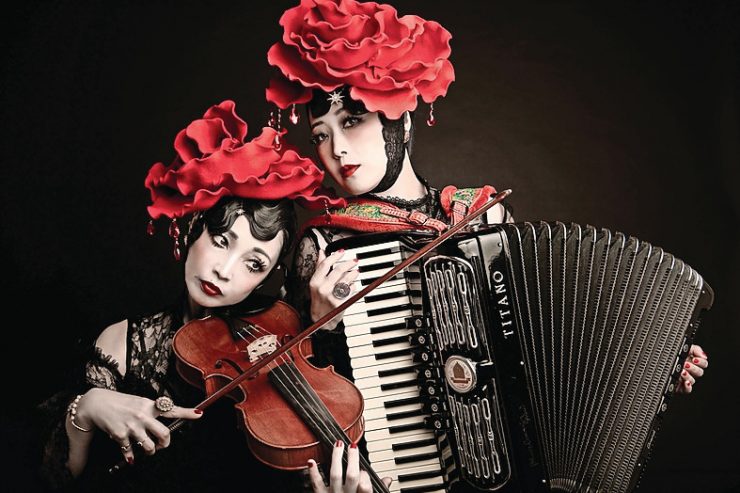Listening to a Kokusyoku Sumire album is akin to opening a vintage music box. What’s inside? A matryoshka doll? An accordionist that plays French chansons? A miniature Italian opera singer? Or a Japanese doll dressed in kimono? When Yuka and Sachi have a say, it ends up being a bit of everything.
Without much ado, they have recently released their tenth album. „Occult“ can be compared to an ancient grimoire, a textbook with spells, that both evokes and invokes magic. The main strength of the band is the fact that it creates its own universe. Resolutely avant-garde, vocalist Yuka and violinist Sachi aren’t afraid of breaking conventions and boundaries, whether they’re geographical, time-related or artistic, taking bits and pieces of music history, putting their own spin on it and reassembling everything into a phantasmagoric fairy tale. The fact that this duo has managed to fill out a stage with only a violin and piano or accordion – sometimes accompanied by other live musicians such as a clarinetist or viola player – for nearly two decades and releases song after song while always delivering something new contributes to the mystery.

Tim Burton is a fan
Unlike what the album cover might imply, the songs aren’t necessarily darker than their previous works. Yuka’s soprano vocals are particularly impressive in „Yakusoku no Amaryllis“ while Sachi’s violin play shines the most in „Watashi no Terrarium“ and „Doppelgänger“. The choir work in „Hoshimeguri no Uta“ on the other hand works incredibly well against a minimalist instrumental. If I had to choose my personal highlight on the album, it would be „Watashi no Terrarium“. The song is truly a Kokusyoku Sumire signature piece and has all the elements one would look for in their works: endearing violin and piano melodies, dramatic vocals, poetic lyrics and an interesting structure.
It’s easy to guess: both artists are classically trained. Yuka combines the delicate expressions in traditional Japanese songs with European opera techniques while also being a fan of British rock and punk music, thereby showcasing vocals that are both haunting and raw. Sachi seamlessly juggles between performing solos and harmonizing with the vocals. Their creativity extends beyond the musical realm, as the artists make their own head pieces and jewelry too and are involved in theatrical productions and animation works. With such eccentric world-building, it is no surprise that the master of gothic fantasy movies Tim Burton is a fan of their music and visits the bar Yuka and Sachi own whenever he comes to Tokyo.

Taisho was the name of the era between 1912 and 1926 in Japan. Just as European countries discovered Japanese art, the people in the land of the rising sun started to wear Western clothes and eat more Western cuisine. The kimono became cheaper and more colorful thanks to the modernization of production techniques while social movements demanded democracy. The so-called moga (modern girls) caused an uproar similar to America’s flappers and Germany’s neue Frauen, with the era thus earning the name of „Japan’s jazz age“. Kokusyoku Sumire’s music mirrors this artistic melting pot and continues to rise above borders, opening the gates into a world where tango, chanson, old fairy tales and modern Japan coexist.
Recommended tracks: „Aiueonigokko“, „Yakusoku no Amaryllis“, „Watashi no Terrarium“
Rating: 9 points out of 10








Sie müssen angemeldet sein um kommentieren zu können